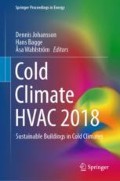Abstract
Existing classification systems linked to the environmental performance of buildings provide limited added value for practitioners. A survey among Swedish construction entrepreneurs showed that there is a real demand for better formulated criteria and clearer guidance. At the same time, critical investigation of requirements based on fixed average values for primary energy factors (such as in the EU Environmental Performance of Buildings Directive) shows that they are insufficient to provide guidance towards environmental sustainability building practices. They fail to take into account a number of methodological issues, including seasonal and hourly variability of energy supply and demand, and the future evolution of energy mixes. This is illustrated in the case of Sweden. The outline of an Open Classification System, currently under development, is then presented. This system focuses on methodological transparency and validity, as well as ease of use for practitioners. It addresses specifically issues where other existing systems were found to be lacking, and its methodology will be assessed to ensure that it provides optimal guidance towards environmentally sustainable practices. The system is based on three criteria: the energy resource index and global warming potential, calculated with attributional and consequential life cycle approaches, and a heat loss factor to assess the building’s energy performance independently from the supply side.
Access this chapter
Tax calculation will be finalised at checkout
Purchases are for personal use only
Notes
- 1.
It is considered to have a PEF of 1 kWh/kWh in the current Swedish building code.
References
Swedish Center for Zero-Energy Houses (2012) Kravspecifikation för nollenergihus, passivhus och minienergihus - Bostäder
Swedish Green Building Center (2017) Miljöbyggnad - Bedömningskriterier för nyproduktion 3.0
European Commission (2016) May infringements’ package : key decisions. http://europa.eu/rapid/press-release_MEMO-16-1823_en.htm. Accessed 17 Aug 2017
BRE Global Limited (2017) BREEAM International New Construction 2016
United States Green Building Council (2014) LEED v4 for Building Design and Construction (Updated April 14, 2017)
European Standards (2011) EN 15978:2011 Sustainability of construction works. Assessment of environmental performance of buildings. Calculation method. https://doi.org/10.3403/30204399
European Standards (2012) EN 15804:2012 Sustainability of construction works, Environmental product declarations, Core rules for the product category of construction products
European Commission – Joint Research Centre – Institute for Environment and Sustainability (2010) International Reference Life Cycle Data System (ILCD) Handbook – General guide for Life Cycle Assessment – Detailed guidance. Constraints. https://doi.org/10.2788/38479
European Parliament, European Council (2010) Directive 2010/31/EU of the European Parliament and of the Council of 19 May 2010 on the energy performance of buildings (recast). Off J Eur Union. doi:https://doi.org/10.3000/17252555.l_2010.153.eng
Boverket, Regelsamling för byggande (BBR, Boverket, Stockholm, 2015)
D. Stoerring, S. Horl, European Parliament fact sheet: internal energy market (2017). http://www.europarl.europa.eu/atyourservice/en/displayFtu.html?ftuId=FTU_5.7.2.html. Accessed 18 Aug 2017
International Energy Agency (2016) Nordic energy technology perspectives 2016. https://doi.org/10.1787/9789264257665-en
J. Gode, F. Martinsson, L. Hagberg et al., Miljöfaktaboken 2011 Uppskattade emissionsfaktorer för bränslen, el, värme och transporter (in Swedish) (Värmeforsk Service AB, Stockholm, 2011)
World Resources Institute, World Business Council for Sustainable Development (2007) Guidelines for Quantifying GHG Reductions from Grid-Connected Electricity Projects
B. Peuportier, C. Roux , Moving towards CLCA to model electricity consumption in buildnings (2015)
A.D. Hawkes, Estimating marginal CO2 emissions rates for national electricity systems. Energy Policy 38, 5977–5987 (2010). https://doi.org/10.1016/j.enpol.2010.05.053
C. Roux, B. Peuportier, Considering temporal variation in the life cycle assessment of buildings, application to electricity consumption and production. World suistainable Build 2014, 1–9 (2014)
J. Gode, A. Lätt, T. Ekvall, et al., Miljövärdering av energilösningar i byggnader - metod för konsekvensanalys. Stockholm (2015)
C. Roux, P. Schalbart, B. Peuportier, Accounting for temporal variation of electricity production and consumption in the LCA of an energy-efficient house. J. Clean. Prod. 113, 532–540 (2016). https://doi.org/10.1016/j.jclepro.2015.11.052
M. Erlandsson, Hållbar användning av naturresurser - andelen nedströms klimatpåverkan för byggnader (2014)
C.K. Anand, B. Amor, Recent developments, future challenges and new research directions in LCA of buildings: a critical review. Renew. Sustain. Energy Rev. 67, 408–416 (2017). https://doi.org/10.1016/j.rser.2016.09.058
T. Ibn-Mohammed, R. Greenough, S. Taylor et al., Operational vs. embodied emissions in buildings—A review of current trends. Energy Build. 66, 232–245 (2013). https://doi.org/10.1016/j.enbuild.2013.07.026
C. Liljenström, T. Malmqvist, M. Erlandsson, et al., Byggandets klimatpåverkan - Livscykelberäkning av klimatpåverkan och energianvändning för ett nyproducerat energieffektivt flerbostadshus i betong. Stockholm (2015)
E. Seinre, J. Kurnitski, H. Voll, Quantification of environmental and economic impacts for main categories of building labeling schemes. Energy Build. 70, 145–158 (2014). https://doi.org/10.1016/j.enbuild.2013.11.048
N. Brown, T. Malmqvist, H. Wintzell, Value creation for tenants in environmentally certified buildings. Build Res Inf 1–16 (2016). https://doi.org/10.1080/09613218.2016.1207137
Acknowledgements
Björn Berggren, from Skanska AB, was responsible for carrying out the initial survey. His help and comments on this article are gratefully acknowledged.
Author information
Authors and Affiliations
Corresponding author
Editor information
Editors and Affiliations
Rights and permissions
Copyright information
© 2019 Springer Nature Switzerland AG
About this paper
Cite this paper
Francart, N., Sandberg, E., Erlandsson, M. (2019). Environmental Sustainability Building Criteria for an Open Classification System. In: Johansson, D., Bagge, H., Wahlström, Å. (eds) Cold Climate HVAC 2018. CCC 2018. Springer Proceedings in Energy. Springer, Cham. https://doi.org/10.1007/978-3-030-00662-4_85
Download citation
DOI: https://doi.org/10.1007/978-3-030-00662-4_85
Published:
Publisher Name: Springer, Cham
Print ISBN: 978-3-030-00661-7
Online ISBN: 978-3-030-00662-4
eBook Packages: EnergyEnergy (R0)

